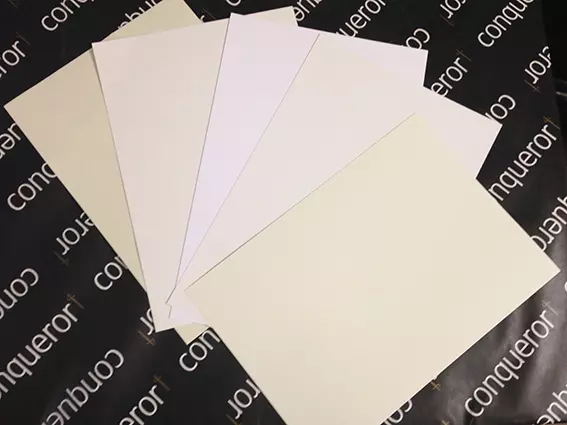MENU
MENU

When choosing the right card or paper for your projects, one of the most important factors to consider is the GSM weight. GSM, which stands for "grams per square metre," is a measure of the thickness and weight of paper or card. Understanding what different GSM weights mean and how they affect the look, feel, and durability of your materials can make all the difference, whether you’re crafting greeting cards, printing invitations, or creating art. In this guide, we’ll break down everything you need to know about GSM weights to help you make the best choice for your needs.
GSM is a metric measurement that indicates how much a sheet of paper or card weighs in grams per square metre. Simply put, the higher the GSM number, the thicker and heavier the paper or card will be. For example, standard printer paper is usually around 80gsm, while a thick card used for luxury invitations could be 300gsm or more. GSM helps to determine the sturdiness and quality of the paper or card, making it a key factor when selecting supplies for different purposes.
Here’s a breakdown of some common GSM weights and what they are typically used for:
At the lower end of the GSM scale, 80-100gsm is the weight of standard printer paper used in offices and homes. It’s lightweight, easy to fold, and works well for everyday printing tasks like documents, letters, and simple flyers. While it is suitable for text-heavy prints, it may not be the best choice for high-quality graphics or projects that require a more premium look.
Slightly heavier than standard printer paper, paper in the range of 120-170gsm is often used for flyers, brochures, and posters. This weight adds a touch of quality and durability while still being light enough for folding. It’s a good choice for materials that need to feel more substantial than printer paper without being overly thick.
Cardstock in the range of 200-250gsm is a popular choice for crafting and card making. It’s thick enough to stand upright and hold its shape, making it suitable for greeting cards, menus, and book covers. This weight is also ideal for scrapbooking and DIY projects that require a sturdy yet flexible card.
300-350gsm is considered medium to heavy card stock and is perfect for projects that need a durable, high-quality finish. This GSM weight is commonly used for wedding invitations, business cards, presentation folders, and premium greeting cards. Its thickness adds a sense of luxury, making it suitable for any project where quality is paramount. This weight of card can support heavier embellishments, such as ribbons or metal charms, without bending.
Card stock that falls within the 400-450gsm range is used for luxury stationery items that need to make a strong impression. It’s thick, rigid, and feels substantial in hand, making it perfect for high-end wedding invitations, luxury business cards, and special occasion cards. This GSM weight is less flexible, which means it may require scoring to fold neatly, especially for projects like invitations or menus.
At the higher end of the GSM scale, 500gsm and above are considered extra heavy card stock. This weight is typically used for speciality items, such as premium packaging, luxury invitations, or art prints that require a rigid surface. It’s less commonly used for everyday crafting but can add an extra touch of quality to high-end projects.
Choosing the right GSM weight depends on several factors, including the purpose of the project, the desired finish, and any additional embellishments or printing requirements. Here are some considerations to keep in mind:
The GSM weight of your paper or card will significantly influence the final appearance and quality of your project. Heavier GSMs generally give a more premium, professional look, while lighter GSMs are suitable for casual or everyday tasks. The right choice can help convey the desired tone and impression, whether you’re aiming for luxury, durability, or practicality.
For businesses, using higher GSM card stock for materials such as business cards or presentation folders can help convey professionalism and quality. In contrast, lighter GSM weights may be appropriate for marketing materials like leaflets or brochures that are produced in large quantities and distributed widely.
Understanding the different GSM weights available for card and paper supplies is key to selecting the best materials for your projects. From lightweight printer paper to extra heavy card stock, each GSM range serves different purposes and offers distinct benefits. By considering the requirements of your project, including the need for durability, printing, and embellishments, you can choose the perfect GSM weight that meets your needs.
Explore Mankey Monkey’s range of card and paper supplies, available in various GSM weights to suit all your crafting, printing, and stationery requirements. Whether you’re creating invitations, business cards, or scrapbook elements, we’ve got the perfect GSM weight to help you achieve the best results.